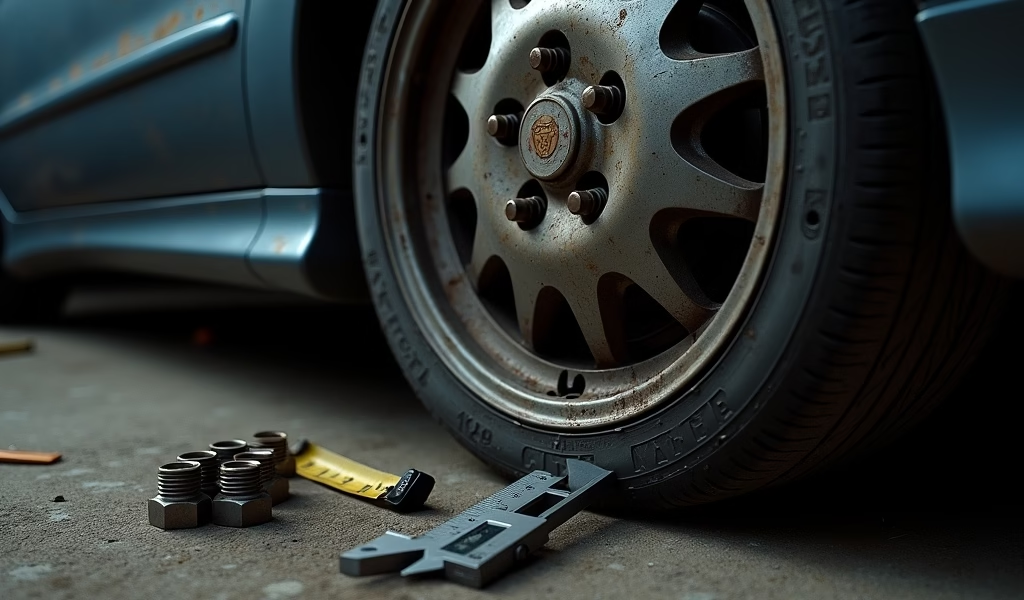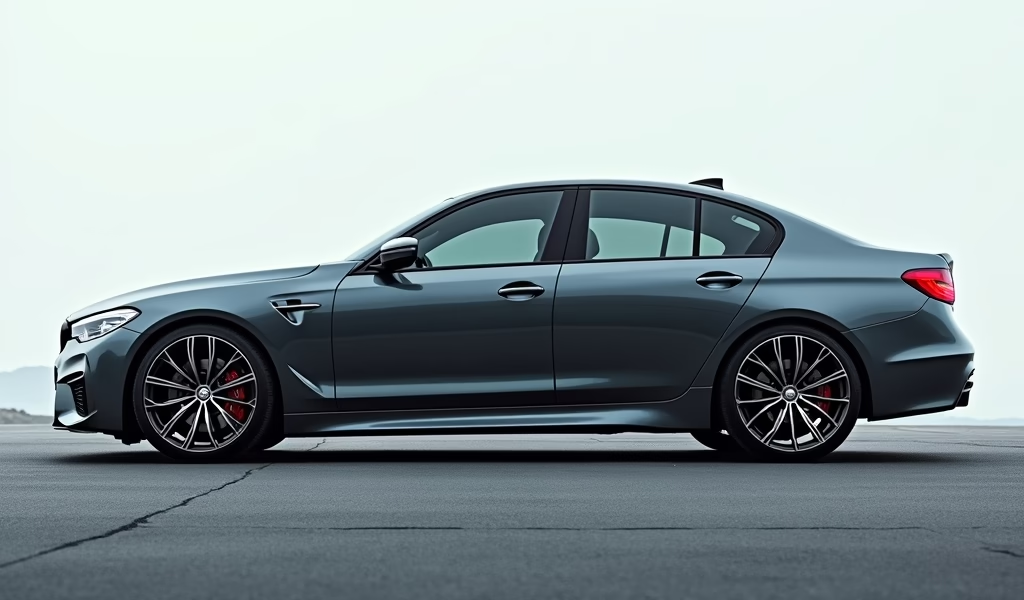Overview
This guide explains how to accurately measure wheel bolt patterns in three steps: count the lugs, measure the bolt circle diameter using vehicle-specific techniques, and determine additional specifications like hub center bore and wheel offset. Written by a 15-year mechanic, it emphasizes that precise measurement prevents safety issues, installation problems, and wasted money on incompatible wheels.
Table of Contents
- Introduction
- Why Accurate Bolt Pattern Measurement Matters
- Step 1: Count the Lugs
- Step 2: Measure the Bolt Circle Diameter
- Step 3: Determine Additional Specifications
- Common Bolt Pattern Measurements by Vehicle Type
- Tools That Make Measurement Easier
- Conclusion
- Frequently Asked Questions
Introduction
I’ve been a mechanic for over 15 years, and if there’s one thing I’ve learned, it’s that wheel bolt patterns can confuse even the most experienced car owners. Trust me, I’ve been there – I once spent an entire Saturday helping my brother-in-law after he ordered a gorgeous set of wheels that wouldn’t fit his Toyota because he measured the bolt pattern incorrectly.
Think of your wheel’s bolt pattern as its fingerprint – unique and essential for proper fitment. It’s defined by two critical measurements: the number of lugs (or bolts) and the diameter of the imaginary circle they form. When you see something like “5×114.3mm” or “6×5.5 inches” in wheel specifications, that’s the bolt pattern speaking to you.
I’ve watched countless customers walk into my shop clutching the wrong wheels, frustration written across their faces. That’s why I created this straightforward guide to wheel measurement that breaks down the process into three manageable steps. Whether you’re a first-time wheel buyer or someone who just wants to double-check before making a purchase, these steps will save you time, money, and headaches.
Why Accurate Bolt Pattern Measurement Matters
Let me tell you about Charlie, a customer who came into my shop after his wheel nearly separated from his car on the highway. The cause? Mismatched bolt patterns creating uneven pressure on the lugs. When bolt patterns don’t align precisely, you’re essentially forcing components together that weren’t designed to mate – a dangerous proposition at any speed.
Beyond the obvious safety concerns (which should be reason enough), incorrect measurements lead to several problems:
- Wheels that simply won’t mount properly on your vehicle
- Excessive vibration that damages bearings and suspension components
- Uneven tire wear that significantly reduces tire life
- The frustration and expense of return shipping when you order the wrong wheels
- Potential damage to wheel studs if you try to force an improper fit
I’ve developed a simple mantra for my customers: “Measure twice, order once.” Those few minutes spent with a tape measure can save you hundreds of dollars and countless hours of aggravation. And unlike many car repairs that require special tools or expertise, this is something you can absolutely master yourself.

Step 1: Count the Lugs
This first step is refreshingly simple – count the number of lugs or bolts on your wheel. This number forms the first part of your bolt pattern specification. I know it seems obvious, but you’d be surprised how often people miscount or assume they know without checking.
Last summer, I had a customer insist his Toyota Tacoma had a 5-lug pattern because his previous truck did. Only when I walked him out to the parking lot did he realize his new truck actually had 6 lugs. Small details matter!
Here’s what you’ll typically find on different vehicle types:
- 4-lug patterns: Common on smaller vehicles like compact cars and some older economy models
- 5-lug patterns: The most common configuration for passenger cars, crossovers, and smaller SUVs
- 6-lug patterns: Typically found on trucks, larger SUVs, and some off-road vehicles
- 8-lug patterns: Reserved for heavy-duty trucks and commercial vehicles
When you see a bolt pattern written as “5×114.3,” that first “5” tells you there are five lugs. Simple enough, right? But don’t skip this step – I once helped a neighbor who thought his truck had a 6-lug pattern, only to discover it actually had 8 lugs after cleaning off years of caked-on mud and grime.
Step 2: Measure the Bolt Circle Diameter
Now comes the part where most people get tripped up – measuring the diameter of the imaginary circle formed by your lugs. The technique varies depending on how many lugs you’re working with.
For 4-lug wheels, it’s straightforward: measure from the center of one lug directly across to the center of the opposite lug. This gives you the bolt circle diameter (BCD) directly. I find it’s easiest to do this with the wheel off the car, but you can manage with it mounted if necessary.
For 5-lug wheels, things get trickier because there isn’t a lug directly opposite another. Here’s how I teach customers to handle this:
- Measure from the center of one lug to the farthest edge of the lug that’s two positions away (not the adjacent one)
- Multiply this measurement by 1.051 to get your bolt circle diameter
- Or save yourself the math and use a bolt pattern gauge (I’ll discuss these tools later)
For 6 and 8-lug wheels, you’re back to the easy method: measure from the center of one lug directly across to the center of the opposite lug.
Pro tip from my years at the shop: Always measure in millimeters for greater precision, even if you’ll convert to inches later. Many bolt patterns differ by just a few millimeters, but those tiny differences can make all the difference between a perfect fit and an expensive mistake.
I remember helping a customer who had already ordered wheels twice for his Subaru, getting it wrong both times. The difference between the 5x100mm pattern he needed and the 5×114.3mm pattern he kept ordering was just 14mm – barely over half an inch – but enough to make the wheels completely incompatible.
Step 3: Determine Additional Specifications
While the bolt pattern is the headline act, there are supporting players that deserve your attention too. These additional specifications ensure your wheels not only fit but perform properly:
Hub Center Bore: This is the center hole in your wheel that centers it on the hub. Using calipers, measure the diameter of this hole with precision. If the center bore is too small, the wheel won’t fit over the hub; if it’s too large, you’ll need hub-centric rings to prevent vibration. I’ve seen wheels with perfect bolt patterns rendered useless because the center bore was off by just a few millimeters.
Wheel Offset: This measures how your wheel is mounted relative to the hub mounting surface. It affects clearance, handling, and appearance. You’ll need to measure from the hub mounting surface to the centerline of the wheel. Positive offset means the mounting surface is toward the front face of the wheel (most common); negative offset pushes the wheel outward for a more aggressive stance.
Thread Size and Lug Type: Are you dealing with lug bolts or lug nuts? What’s the thread pitch? These details matter for proper torquing and safety. You can use a thread pitch gauge or take one of your existing lugs to an auto parts store for matching.
When complete, you’ll have a specification that looks something like: “5×114.3mm, 67.1mm center bore, +45mm offset, M12x1.5 lug nuts.” That’s your wheel’s complete identity card – the exact information you need when shopping for new wheels.
I once had a customer bring in a beautiful set of aftermarket wheels with the correct bolt pattern for his BMW, but the offset was wrong by just 5mm. That tiny difference caused the wheels to rub against his brake calipers during turns. Wheel width compatibility and these additional specifications might seem like minor details, but they can make or break your wheel fitment.

Common Bolt Pattern Measurements by Vehicle Type
After working on thousands of vehicles over my career, I’ve noticed some patterns emerge (pun absolutely intended). While you should always measure your specific vehicle, these common patterns might give you a head start:
Popular Passenger Cars:
- 5×114.3mm (5×4.5″): The “Japanese standard” found on most Honda, Toyota, Nissan models
- 5x112mm: The “German standard” used by Volkswagen, Audi, and Mercedes
- 5x100mm: Common on Subarus and some Toyota models
- 4x100mm: The compact car favorite for Honda, Mazda, and many older imports
Trucks and SUVs:
- 6×139.7mm (6×5.5″): The king of truck patterns, found on Toyota, GM, and Nissan trucks
- 8×165.1mm (8×6.5″): Heavy-duty Ford, GMC, and Chevy trucks
- 5x127mm (5×5″): Jeep and some American SUVs
Regional Differences:
One fascinating pattern I’ve noticed is how manufacturers cluster by region. European manufacturers tend toward 5x112mm or 5x120mm, while American vehicles often use inch-based measurements like 5×4.5″ (which is 5×114.3mm). Asian manufacturers commonly use 4x100mm, 5x100mm, or 5×114.3mm.
I once had a client absolutely convinced their European luxury SUV had the same bolt pattern as their Japanese sedan because “they looked the same.” After careful measurement, we discovered they were off by just 5mm – small enough to fool the eye but large enough to prevent proper installation.
Always verify your specific model, though. I’ve seen many exceptions to these rules, especially with newer vehicles as global parts sharing becomes more common. According to research from Wheel-Size.com, the 5×114.3mm pattern has become increasingly universal, appearing on vehicles from almost every manufacturer.
Tools That Make Measurement Easier
While you can measure bolt patterns with a tape measure and calculator in a pinch, I’ve invested in specialized tools over the years that make the job quicker and more accurate:
- Bolt Pattern Gauges: These purpose-built tools instantly identify common bolt patterns without calculations. I use mine daily in the shop, and it’s paid for itself many times over.
- Digital Calipers: Precise to fractions of a millimeter, these are invaluable for center bore measurements and other detailed work.
- Wheel Fitment Apps: Several smartphone applications can now identify bolt patterns using your camera and augmented reality. While not as reliable as physical measurement, they can provide a good starting point.
- Thread Pitch Gauges: Essential for identifying the correct lug nuts or bolts for your wheels.
In my shop, we use the ProForm Digital Bolt Pattern Gauge, which has saved us countless hours and virtually eliminated measurement errors. It’s an investment that pays for itself after just a few wheel purchases. For home mechanics, Tire Rack offers excellent measurement guides that can help you navigate the process with basic tools.
The most expensive tool in my collection cost about $75, but I’ve seen it save customers thousands in avoided mistakes. That’s what I call a good return on investment!
Conclusion
Measuring your wheel’s bolt pattern doesn’t require special training or mechanical genius – just three simple steps:
- Count the lugs
- Measure the bolt circle diameter
- Determine additional specifications
By taking just 10 minutes to accurately measure your bolt pattern, you’re not just buying the right wheels; you’re investing in safety, performance, and peace of mind. Remember, your wheels are the only contact points between your vehicle and the road – they deserve your attention to detail.
In my years turning wrenches, I’ve seen too many preventable mistakes and near-misses caused by incorrect wheel fitment. Whether you’re upgrading to fancy aftermarket wheels or just replacing a damaged factory rim, proper measurement is the foundation of a successful wheel purchase.
And if you find yourself staring at your wheel with a tape measure in hand and doubt in your heart, don’t worry. Most local mechanics (myself included) would rather help you measure correctly than see you struggle with improper fitment later. We’re in this together, after all – just a community of car people trying to keep our vehicles rolling smoothly down the road.
Frequently Asked Questions
What happens if I install wheels with the wrong bolt pattern?
Best case, they simply won’t fit on your vehicle. Worst case, they might partially fit but create dangerous conditions that could lead to wheel separation while driving.
Can I use adapters to fit wheels with different bolt patterns?
Yes, bolt pattern adapters exist, but they add complexity and potential failure points. I only recommend them as a last resort when no direct-fit options are available.
What’s the difference between wheel bolt pattern and stud pattern?
Nothing – these terms are interchangeable. They both refer to the arrangement of lug studs or bolt holes on your wheel.
Do all vehicles of the same make use identical bolt patterns?
No, different models from the same manufacturer often use different patterns. Always check your specific model rather than assuming based on the brand.
How do I convert a bolt pattern from inches to millimeters?
Multiply the inch measurement by 25.4 to get millimeters. For example, 5×4.5″ equals 5×114.3mm.


Pingback: Wheel Stud Replacement Procedure: 5 Tips - knowsyourcar.com